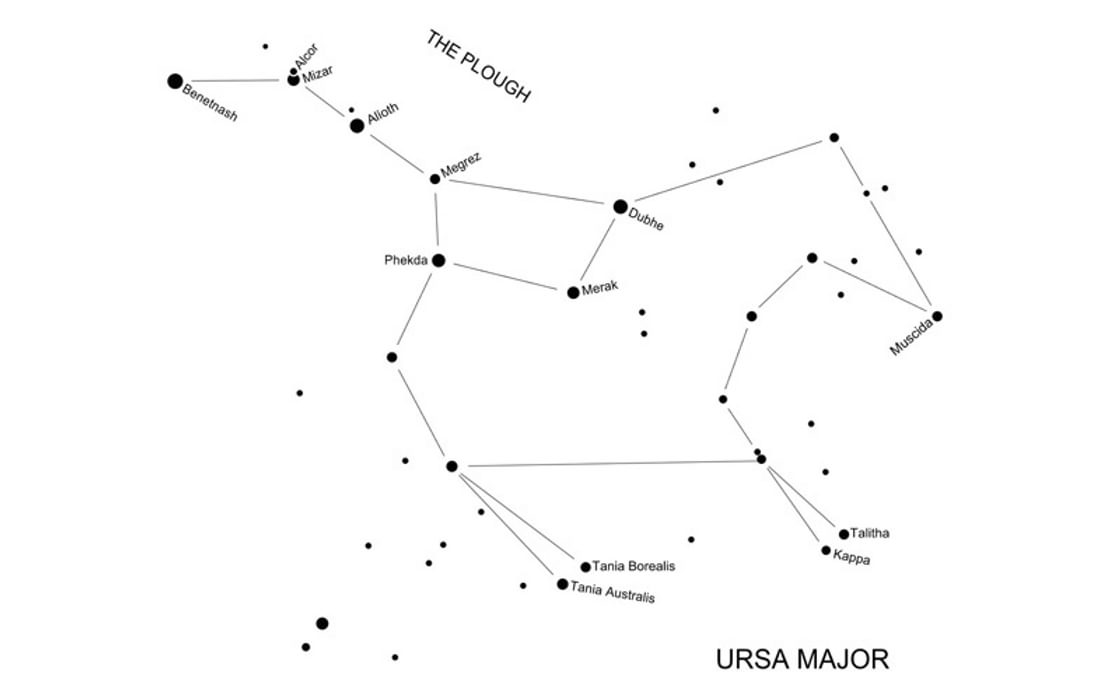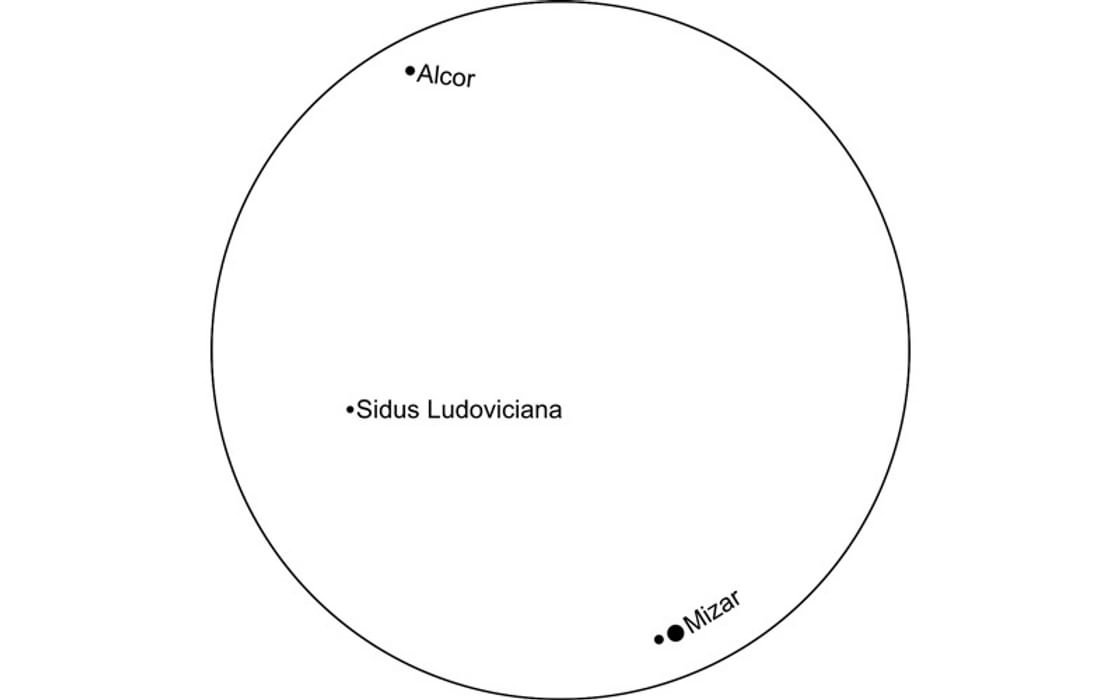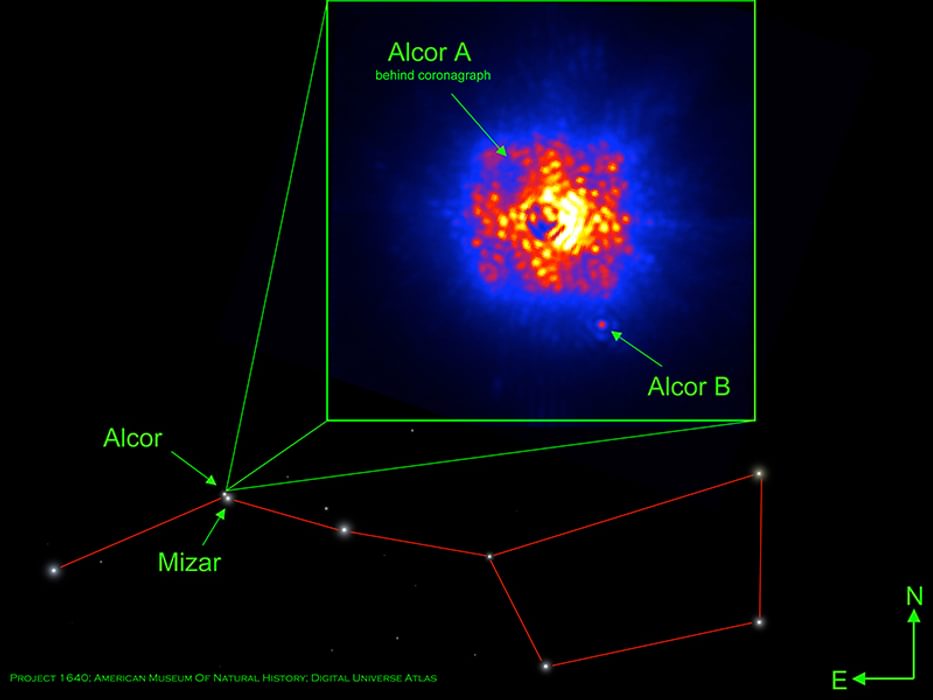Skywatch Summer: Ursa Major
Even if you’ve not heard of Alcor, Mizar or Liebknecht’s ‘spurious planet’ you’ve probably heard of the Great Bear (or the Plough which is part of the Great Bear). It’s one of the big beasts of the summer night sky in the northern hemisphere. Here author and astronomer Brian Jones gives you a little more to ponder on as you gaze upwards from that Highland bothy or bivvy site!
The Great Bear
Shaped rather like a gigantic heavenly spoon the Plough is probably the best-known pattern of stars in the sky, being part of the much larger constellation Ursa Major (the Great Bear). The other stars in the Great Bear spread out and away from those in the Plough and are all comparatively faint, although they can be picked out fairly easily on a clear night. The Plough itself, however, which marks the hind quarters and tail of the Great Bear, stand out quite well.
One of Ursa Major’s claims to fame is that the constellation actually does resemble the object or character that it depicts! Checking out the group as a whole you will see that, as well as the tail and hindquarters being well defined, the legs and head of the Great Bear are also clearly represented, its front paws depicted by Kappa and Talitha, the hind feet by the two stars Tania Borealis and Tania Australis and its nose by Muscida

As far as observers throughout most of Europe, Canada, the northern United States and Russia go, Ursa Major is a circumpolar constellation, which means that it never actually sets but always remains above the horizon. Ramblers and star gazers at these latitudes will see the Plough, together with the rest of Ursa Major, riding high in the sky during spring evenings, located at or near the overhead point with its tail pointing down towards the south. As the year wears on and spring turns to summer, the constellation slowly drops down into the high north west and eventually ends up lying over the northern horizon during the autumn months. The advent of winter evenings sees the Great Bear rising in the north east from where its annual cycle around the northern skies stars again.
The celestial bear’s year-long progression around the northern heavens gave rise to one of the many legends attached to the constellation, in particular to the stars forming the Plough. The North American Indians identified the four stars in the ‘bowl’ of the Plough as a bear which was being pursued around the sky by three hunters, represented by the three stars in the Plough ‘handle’. The faint star Alcor (see below) represents the cooking pot optimistically carried by the middle of the three hunters! From being high in the north western sky in winter the bear is chased around the sky until autumn when it is eventually caught. At this time, and from mid-northern latitudes, the group can be seen low over the northern horizon, the blood from the bear supposedly dripping down onto the earth, turning the leaves brown.
As with many of the constellations, the stars that form Ursa Major only happen to lie in more-or-less the same line of sight as seen from our planet. Consequently, they only appear to be close together in the sky and, if viewed from elsewhere in our Galaxy, the arrangement of the stars forming Ursa Major would have little or no resemblance to the constellation we see from Earth.
For example, the yellow giant star Muscida shines from a distance of almost 180 light years, putting it over twice as far away as Merak. Located in the bear’s hindquarters, the light we see from Merak set off towards us around 80 years ago. Slightly to the north of Merak is Dubhe which lies roughly midway between the two, its light having taken 125 years to reach us.
The brightest star in Ursa Major is Alioth, located in the Plough handle and shining at magnitude 1.76 from a distance of 83 light years. Slightly fainter is Betetnash, the star at the end of the plough handle, the magnitude 1.85 glow of which set off towards us a little over a century ago.
The names of the stars in Ursa Major are both interesting and varied and generally follow the theme of ursine body parts. Amongst these descriptively-titled stars is Dubhe which derives its name from the Arabic ‘al-dubb’ meaning ‘the Bear’ whilst Merak comes from the Arabic for ‘The Groin (of the Great Bear)’. The name Megrez comes from an abbreviation of the Arabic for ‘The Root of the Tail’ while the star Phekda takes its name from ‘fakhidh al-dubb al-akbar’ meaning ‘The Thigh’. Moving away from the bear-related theme is Alioth, a star which derives its name from the Arabic for ‘the Black Horse, or Bull’.

Alcor, Mizar and a spurious planet
While you’re checking out the Plough, take a close look at the star in the middle of the Plough ‘handle’. You will see that this is actually a pair of stars comprising Mizar – the brighter of the two at magnitude 2.23 – and a nearby magnitude 3.99 companion star Alcor. Both Alcor and Mizar can be made out individually if you have really keen eyesight and if the sky is very dark and clear, although binoculars may be needed to bring the pair out well. If you have powerful binoculars, or a small telescope, you may see another, much fainter star, forming a triangle with Alcor and Mizar, as shown on the chart.
This 8th magnitude star bears the somewhat-clumsy name of Sidus Ludoviciana (Ludwig’s Star) and was named as such by the eccentric German astronomer Johann Georg Liebknecht in December 1722. Spotting the star in his telescope and thinking he had discovered a new planet he named it after his sovereign and patron the Landgrave Ludwig of Hessen-Darmstadt. Liebknecht published details of his ‘find’ and notified many of the leading astronomers of the time. The discovery turned out to be erroneous, although the unusual name he gave to the star remained. Sidus Ludoviciana is not physically associated with Mizar and Alcor and only happens to lie in the same line of sight as seen from our position in space.
Both Mizar and Alcor lie at a distance of around 82 light years, somewhat closer than Sidus Ludoviciana whose light has taken around 400 years to reach us.
If you have a small telescope take a closer look at Mizar itself, which turns out to be a close double star with a faint magnitude 4 companion lying close by. Mizar appears to be one of the first double stars to be discovered with a telescope, this being in around 1650 by the Italian astronomer Giovanni Battista Riccioli.

Copyright © American Museum of Natural History.
Downloading the Atlas
AMNH offers the Atlas free of charge via their website, http://www.haydenplanetarium.org
To read more articles like this get our newsletter
Sign up for 20% off your next purchase and to be the first to hear about exclusive competitions, special offers, and news from Cicerone.











